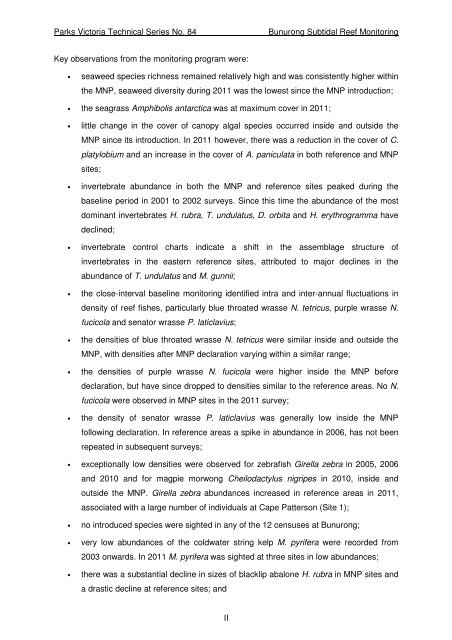the reef biota at bunurong marine national park - Parks Victoria
the reef biota at bunurong marine national park - Parks Victoria
the reef biota at bunurong marine national park - Parks Victoria
You also want an ePaper? Increase the reach of your titles
YUMPU automatically turns print PDFs into web optimized ePapers that Google loves.
<strong>Parks</strong> <strong>Victoria</strong> Technical Series No. 84<br />
Bunurong Subtidal Reef Monitoring<br />
Key observ<strong>at</strong>ions from <strong>the</strong> monitoring program were:<br />
• seaweed species richness remained rel<strong>at</strong>ively high and was consistently higher within<br />
<strong>the</strong> MNP, seaweed diversity during 2011 was <strong>the</strong> lowest since <strong>the</strong> MNP introduction;<br />
• <strong>the</strong> seagrass Amphibolis antarctica was <strong>at</strong> maximum cover in 2011;<br />
• little change in <strong>the</strong> cover of canopy algal species occurred inside and outside <strong>the</strong><br />
MNP since its introduction. In 2011 however, <strong>the</strong>re was a reduction in <strong>the</strong> cover of C.<br />
pl<strong>at</strong>ylobium and an increase in <strong>the</strong> cover of A. panicul<strong>at</strong>a in both reference and MNP<br />
sites;<br />
• invertebr<strong>at</strong>e abundance in both <strong>the</strong> MNP and reference sites peaked during <strong>the</strong><br />
baseline period in 2001 to 2002 surveys. Since this time <strong>the</strong> abundance of <strong>the</strong> most<br />
dominant invertebr<strong>at</strong>es H. rubra, T. undul<strong>at</strong>us, D. orbita and H. erythrogramma have<br />
declined;<br />
• invertebr<strong>at</strong>e control charts indic<strong>at</strong>e a shift in <strong>the</strong> assemblage structure of<br />
invertebr<strong>at</strong>es in <strong>the</strong> eastern reference sites, <strong>at</strong>tributed to major declines in <strong>the</strong><br />
abundance of T. undul<strong>at</strong>us and M. gunnii;<br />
• <strong>the</strong> close-interval baseline monitoring identified intra and inter-annual fluctu<strong>at</strong>ions in<br />
density of <strong>reef</strong> fishes, particularly blue thro<strong>at</strong>ed wrasse N. tetricus, purple wrasse N.<br />
fucicola and sen<strong>at</strong>or wrasse P. l<strong>at</strong>iclavius;<br />
• <strong>the</strong> densities of blue thro<strong>at</strong>ed wrasse N. tetricus were similar inside and outside <strong>the</strong><br />
MNP, with densities after MNP declar<strong>at</strong>ion varying within a similar range;<br />
• <strong>the</strong> densities of purple wrasse N. fucicola were higher inside <strong>the</strong> MNP before<br />
declar<strong>at</strong>ion, but have since dropped to densities similar to <strong>the</strong> reference areas. No N.<br />
fucicola were observed in MNP sites in <strong>the</strong> 2011 survey;<br />
• <strong>the</strong> density of sen<strong>at</strong>or wrasse P. l<strong>at</strong>iclavius was generally low inside <strong>the</strong> MNP<br />
following declar<strong>at</strong>ion. In reference areas a spike in abundance in 2006, has not been<br />
repe<strong>at</strong>ed in subsequent surveys;<br />
• exceptionally low densities were observed for zebrafish Girella zebra in 2005, 2006<br />
and 2010 and for magpie morwong Cheilodactylus nigripes in 2010, inside and<br />
outside <strong>the</strong> MNP. Girella zebra abundances increased in reference areas in 2011,<br />
associ<strong>at</strong>ed with a large number of individuals <strong>at</strong> Cape P<strong>at</strong>terson (Site 1);<br />
• no introduced species were sighted in any of <strong>the</strong> 12 censuses <strong>at</strong> Bunurong;<br />
• very low abundances of <strong>the</strong> coldw<strong>at</strong>er string kelp M. pyrifera were recorded from<br />
2003 onwards. In 2011 M. pyrifera was sighted <strong>at</strong> three sites in low abundances;<br />
• <strong>the</strong>re was a substantial decline in sizes of blacklip abalone H. rubra in MNP sites and<br />
a drastic decline <strong>at</strong> reference sites; and<br />
II

















